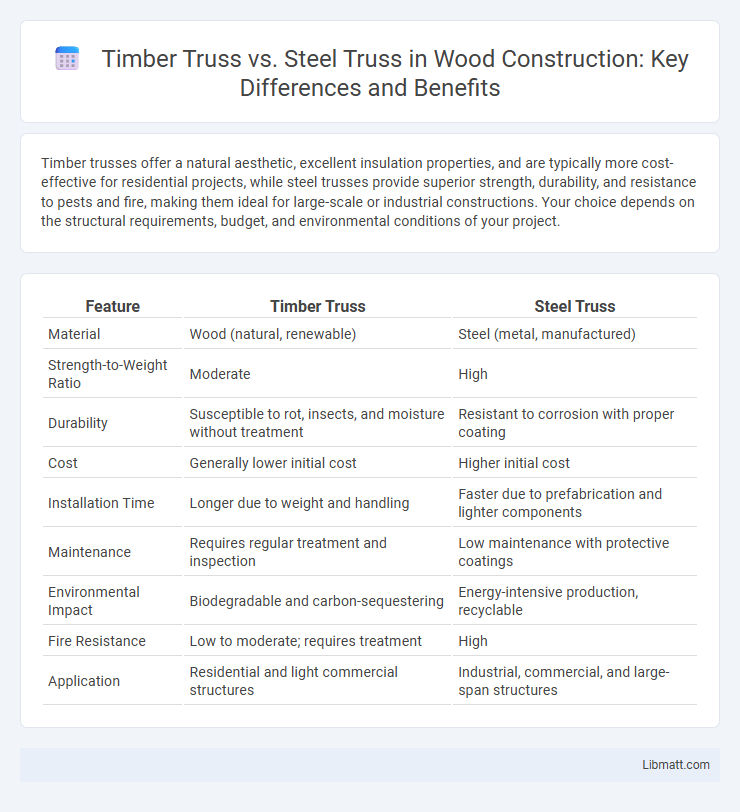Timber trusses offer a natural aesthetic, excellent insulation properties, and are typically more cost-effective for residential projects, while steel trusses provide superior strength, durability, and resistance to pests and fire, making them ideal for large-scale or industrial constructions. Your choice depends on the structural requirements, budget, and environmental conditions of your project.
Table of Comparison
| Feature | Timber Truss | Steel Truss |
|---|---|---|
| Material | Wood (natural, renewable) | Steel (metal, manufactured) |
| Strength-to-Weight Ratio | Moderate | High |
| Durability | Susceptible to rot, insects, and moisture without treatment | Resistant to corrosion with proper coating |
| Cost | Generally lower initial cost | Higher initial cost |
| Installation Time | Longer due to weight and handling | Faster due to prefabrication and lighter components |
| Maintenance | Requires regular treatment and inspection | Low maintenance with protective coatings |
| Environmental Impact | Biodegradable and carbon-sequestering | Energy-intensive production, recyclable |
| Fire Resistance | Low to moderate; requires treatment | High |
| Application | Residential and light commercial structures | Industrial, commercial, and large-span structures |
Introduction to Timber and Steel Trusses
Timber trusses are crafted from wood, offering natural insulation and aesthetic warmth ideal for residential and light commercial buildings. Steel trusses utilize metal components, providing superior strength, durability, and resistance to fire and pests, making them suitable for large-span structures and industrial applications. Your choice between timber and steel trusses depends on factors like structural requirements, budget, and architectural design preferences.
Material Properties: Timber vs Steel
Timber trusses offer natural insulation, lower weight, and sustainability due to their renewable origin, while steel trusses provide superior strength, durability, and resistance to pests and fire. Timber's flexibility suits curved designs, but steel's high tensile strength enables longer spans and heavier loads without deformation. Your choice depends on project requirements, balancing timber's aesthetic and eco-friendliness against steel's performance and longevity.
Cost Comparison: Timber Truss vs Steel Truss
Timber trusses generally offer lower initial material costs compared to steel trusses, making them a budget-friendly choice for residential projects. Steel trusses, while more expensive upfront, provide longer durability and reduced maintenance expenses over time, which can translate into cost savings for commercial buildings. Your decision should weigh both immediate budget constraints and long-term value, considering factors like project scale and lifespan.
Structural Strength and Load-Bearing Capacity
Steel trusses exhibit superior structural strength and load-bearing capacity compared to timber trusses, making them ideal for long spans and heavy loads in industrial and commercial construction. Timber trusses offer a favorable strength-to-weight ratio but are limited by material properties, often requiring larger cross-sections to achieve similar load capacities. The inherent durability and high tensile strength of steel enable it to resist bending, shear, and compression forces more effectively under dynamic and static loads.
Durability and Longevity Factors
Timber trusses offer natural resistance to environmental factors but require regular maintenance to prevent decay, insect infestation, and warping, which can shorten their lifespan. Steel trusses provide superior durability and longevity due to their resistance to corrosion, pests, and fire, making them ideal for long-term structural integrity when properly coated and maintained. The choice between timber and steel trusses depends on environmental exposure, maintenance capacity, and the desired lifespan of the structure.
Environmental Impact and Sustainability
Timber trusses offer a lower environmental impact due to their renewable nature and carbon sequestration properties, making them a sustainable choice for eco-conscious construction. Steel trusses, while durable and recyclable, require significant energy for production, contributing to a higher carbon footprint. Your decision between timber and steel trusses should consider the balance between sustainability goals and structural requirements.
Design Flexibility and Customization
Timber trusses offer significant design flexibility due to their ease of cutting and shaping, allowing for intricate, custom patterns that suit traditional and rustic aesthetics. Steel trusses provide greater customization options for complex engineering requirements, supporting longer spans and unconventional shapes with high precision using advanced fabrication techniques. Choosing between timber and steel trusses depends on your project's structural demands and desired architectural style.
Installation Process and Construction Time
Timber truss installation typically involves lighter materials that are easier to handle on-site, often reducing labor time and allowing for faster assembly with basic tools. Steel trusses require precise welding or bolting, which can extend the construction time due to the need for specialized labor and equipment, but their prefabrication can offset on-site delays. Your choice will impact the overall project timeline depending on the skillset of the workforce and site conditions.
Maintenance Requirements and Lifespan
Timber trusses require regular inspections for rot, insect damage, and moisture exposure, impacting their maintenance frequency compared to steel trusses, which resist corrosion and pests but need protection against rust and structural fatigue. Steel trusses typically offer a longer lifespan, often exceeding 50 years, while timber trusses average around 30 to 40 years depending on environmental conditions and treatment quality. Choosing the right truss affects your maintenance schedule and long-term durability, ensuring optimal structural performance over time.
Choosing the Right Truss for Your Project
Choosing the right truss for your project depends on factors such as load requirements, environmental conditions, and budget constraints. Timber trusses offer natural insulation, aesthetic appeal, and sustainability, making them ideal for residential and low-rise buildings, while steel trusses provide superior strength, durability, and resistance to pests and fire, suited for industrial and large-span structures. Evaluating your project's structural demands and long-term maintenance needs will help you determine whether timber or steel trusses best support your design and performance goals.
Timber truss vs Steel truss Infographic

 libmatt.com
libmatt.com